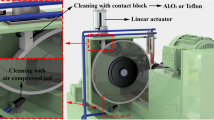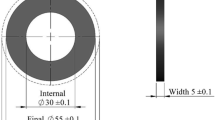Abstract
The minimum quantity lubrication (MQL) is one of the most promising alternative techniques to replace the conventional application of cutting fluids. However, its use in grinding is still a challenge, as overheating and wheel clogging occur, leading to workpiece quality worsening. This work investigates a wheel cleaning jet associated with the MQL (MQL+WCJ) at three flow rates in grinding of AISI 4340 hardened steel with a cBN wheel, comparing the results with MQL and conventional methods. The output parameters assessed were workpiece surface roughness, roundness deviation, and microhardness, diametrical wheel wear, acoustic emission, and grinding power, and the machined surfaces were analyzed through microscopy techniques (optical, scanning electron, and confocal). The MQL+WCJ outperformed MQL in all the tested conditions. The application of the wheel cleaning jet reduced by up to 73% the wheel wear, 69% the surface roughness, 45% the roundness deviation, 60% the acoustic emission, and 24% the grinding power, regarding MQL without wheel cleaning, contributing to a more environmentally friendly and efficient grinding.














Similar content being viewed by others
References
Sato BK, Rodriguez RL, Talon AG et al (2019) Grinding performance of AISI D6 steel using CBN wheel vitrified and resinoid bonded. Int J Adv Manuf Technol:2167–2182. https://doi.org/10.1007/s00170-019-04407-5
Lopes JC, Fernandes L d M, Tavares AB et al (2019) Application of a wheel cleaning system during grinding of alumina with minimum quantity lubrication. Int J Adv Manuf Technol 102:333–341. https://doi.org/10.1007/s00170-018-3174-4
Malkin S, Guo C (2007) Thermal analysis of grinding. CIRP Ann - Manuf Technol 56:760–782. https://doi.org/10.1016/j.cirp.2007.10.005
Ding Z, Jiang X, Guo M, Liang SY (2018) Investigation of the grinding temperature and energy partition during cylindrical grinding. Int J Adv Manuf Technol 97:1767–1778. https://doi.org/10.1007/s00170-018-1900-6
Li HN, Axinte D (2018) On the inverse design of discontinuous abrasive surface to lower friction-induced temperature in grinding: an example of engineered abrasive tools. Int J Mach Tools Manuf 132:50–63. https://doi.org/10.1016/j.ijmachtools.2018.04.006
de Martini FL, Lopes JC, Volpato RS et al (2018) Comparative analysis of two CBN grinding wheels performance in nodular cast iron plunge grinding. Int J Adv Manuf Technol 98:237–249. https://doi.org/10.1007/s00170-018-2133-4
Javaroni RL, Lopes JC, Sato BK et al (2019) Minimum quantity of lubrication (MQL) as an eco-friendly alternative to the cutting fluids in advanced ceramics grinding. Int J Adv Manuf Technol 103. https://doi.org/10.1007/s00170-019-03697-z
Brinksmeier E, Meyer D, Huesmann-Cordes AG, Herrmann C (2015) Metalworking fluids - mechanisms and performance. CIRP Ann - Manuf Technol 64:605–628. https://doi.org/10.1016/j.cirp.2015.05.003
Debnath S, Reddy MM, Yi QS (2014) Environmental friendly cutting fluids and cooling techniques in machining: a review. J Clean Prod 83:33–47. https://doi.org/10.1016/j.jclepro.2014.07.071
Benedicto E, Carou D, Rubio EM (2017) Technical, economic and environmental review of the lubrication/cooling systems used in machining processes. Procedia Eng 184:99–116. https://doi.org/10.1016/j.proeng.2017.04.075
Shokoohi Y, Khosrojerdi E, Rassolian Shiadhi BH (2015) Machining and ecological effects of a new developed cutting fluid in combination with different cooling techniques on turning operation. J Clean Prod 94:330–339
Kuram E, Ozcelik B, Bayramoglu M et al (2013) Optimization of cutting fluids and cutting parameters during end milling by using D-optimal design of experiments. J Clean Prod 42:159–166. https://doi.org/10.1016/j.jclepro.2012.11.003
Shokrani A, Dhokia V, Newman ST (2012) Environmentally conscious machining of difficult-to-machine materials with regard to cutting fluids. Int J Mach Tools Manuf 57:83–101. https://doi.org/10.1016/j.ijmachtools.2012.02.002
Goindi GS, Sarkar P (2017) Dry machining: a step towards sustainable machining – challenges and future directions. J Clean Prod 165:1557–1571. https://doi.org/10.1016/j.jclepro.2017.07.235
Silva LR, Corrêa ECS, Brandão JR, de Ávila RF (2013) Environmentally friendly manufacturing: behavior analysis of minimum quantity of lubricant - MQL in grinding process. J Clean Prod. https://doi.org/10.1016/j.jclepro.2013.01.033
Sharma VS, Singh G, Sorby K (2015) A review on minimum quantity lubrication for machining processes. Mater Manuf Process 30:935–953. https://doi.org/10.1080/10426914.2014.994759
Singh H, Sharma VS, Singh S, Dogra M (2019) Nanofluids assisted environmental friendly lubricating strategies for the surface grinding of titanium alloy: Ti6Al4V-ELI. J Manuf Process 39:241–249. https://doi.org/10.1016/j.jmapro.2019.02.004
Wang Y, Li C, Zhang Y et al (2016) Experimental evaluation of the lubrication properties of the wheel/workpiece interface in MQL grinding with different nanofluids. Tribol Int 99:198–210. https://doi.org/10.1016/j.triboint.2016.03.023
Boswell B, Islam MN, Davies IJ et al (2017) A review identifying the effectiveness of minimum quantity lubrication (MQL) during conventional machining. Int J Adv Manuf Technol 92:321–340. https://doi.org/10.1007/s00170-017-0142-3
Zhang Y, Li C, Jia D et al (2015) Experimental evaluation of MoS2 nanoparticles in jet MQL grinding with different types of vegetable oil as base oil. J Clean Prod 87:930–940. https://doi.org/10.1016/j.jclepro.2014.09.027
Lopes JC, Garcia MV, Valentim M, Javaroni RL, Ribeiro FSF, Angelo Sanchez LE, Mello HJ, Aguiar PR, Bianchi EC (2019) Grinding performance using variants of the MQL technique: MQL with cooled air and MQL simultaneous to the wheel cleaning jet. Int J Adv Manuf Technol 105:4429–4442. https://doi.org/10.1007/s00170-019-04574-5
Hadad M (2015) An experimental investigation of the effects of machining parameters on environmentally friendly grinding process. J Clean Prod 108:217–231. https://doi.org/10.1016/j.jclepro.2015.05.092
Bianchi EC, Rodriguez RL, Hildebrandt RA et al (2018) Plunge cylindrical grinding with the minimum quantity lubrication coolant technique assisted with wheel cleaning system. Int J Adv Manuf Technol 95:2907–2916. https://doi.org/10.1007/s00170-017-1396-5
Rodriguez RL, Lopes JC, Mancini SD, Ângelo Sanchez LE, Almeida Varasquim FMF, Volpato RS, Mello HJ, Aguiar PR, Bianchi EC (2019) Contribution for minimization the usage of cutting fluids in CFRP grinding. Int J Adv Manuf Technol 103:487–497. https://doi.org/10.1007/s00170-019-03529-0
Rodriguez RL, Lopes JC, Hildebrandt RA et al (2019) Evaluation of grinding process using simultaneously MQL technique and cleaning jet on grinding wheel surface. J Mater Process Technol 271:357–367. https://doi.org/10.1016/j.jmatprotec.2019.03.019
Bianchi EC, Sato BK, Sales AR et al (2018) Evaluating the effect of the compressed air wheel cleaning in grinding the AISI 4340 steel with CBN and MQL with water. Int J Adv Manuf Technol 95:2855–2864. https://doi.org/10.1007/s00170-017-1433-4
Hadad MJ, Tawakoli T, Sadeghi MH, Sadeghi B (2012) Temperature and energy partition in minimum quantity lubrication-MQL grinding process. Int J Mach Tools Manuf 54–55:10–17. https://doi.org/10.1016/j.ijmachtools.2011.11.010
Herman D, Krzos J (2009) Influence of vitrified bond structure on radial wear of cBN grinding wheels. J Mater Process Technol 209:5377–5386. https://doi.org/10.1016/j.jmatprotec.2009.03.013
Kopac J, Krajnik P (2006) High-performance grinding-a review. J Mater Process Technol 175:278–284. https://doi.org/10.1016/j.jmatprotec.2005.04.010
Oliveira DDJ, Guermandi LG, Bianchi EC et al (2012) Improving minimum quantity lubrication in CBN grinding using compressed air wheel cleaning. J Mater Process Technol 212:2559–2568. https://doi.org/10.1016/j.jmatprotec.2012.05.019
Malkin S, Guo C (2008) Grinding technology: theory and applications of machining with abrasives, 2a edn. Industrial Press Inc, New York
Lopes JC, Fragoso KM, Garcia MV, Ribeiro FSF, Francelin AP, Angelo Sanchez LE, Rodrigues AR, Mello HJ, Aguiar PR, Bianchi EC (2019) Behavior of hardened steel grinding using MQL under cold air and MQL CBN wheel cleaning. Int J Adv Manuf Technol 105:4373–4387. https://doi.org/10.1007/s00170-019-04571-8
Novovic D, Dewes RC, Aspinwall DK et al (2004) The effect of machined topography and integrity on fatigue life. Int J Mach Tools Manuf 44:125–134. https://doi.org/10.1016/j.ijmachtools.2003.10.018
de Mello HJ, de Mello DR, Rodriguez RL et al (2018) Contribution to cylindrical grinding of interrupted surfaces of hardened steel with medium grit wheel. Int J Adv Manuf Technol 95:4049–4057. https://doi.org/10.1007/s00170-017-1552-y
Belentani R d M, Funes Júnior H, Canarim RC et al (2013) Utilization of minimum quantity lubrication (MQL) with water in CBN grinding of steel. Mater Res 17:88–96. https://doi.org/10.1590/s1516-14392013005000165
Bianchi EC, Rodriguez RL, Hildebrandt RA et al (2019) Application of the auxiliary wheel cleaning jet in the plunge cylindrical grinding with minimum quantity lubrication technique under various flow rates. Proc Inst Mech Eng Part B J Eng Manuf 233:1144–1156. https://doi.org/10.1177/0954405418774599
Garcia MV, Lopes JC, Diniz AE et al (2020) Grinding performance of bearing steel using MQL under different dilutions and wheel cleaning for green manufacture. J Clean Prod 120376. https://doi.org/10.1016/j.jclepro.2020.120376
Tawakoli T, Hadad MJ, Sadeghi MH (2010) Influence of oil mist parameters on minimum quantity lubrication – MQL grinding process. Int J Mach Tools Manuf 50:521–531. https://doi.org/10.1016/j.ijmachtools.2010.03.005
Huang X, Ren Y, Li T et al (2018) Influence of minimum quantity lubrication parameters on grind-hardening process. Mater Manuf Process 33:69–76. https://doi.org/10.1080/10426914.2016.1269916
Ramesh K, Huang H, Yin L (2004) Analytical and experimental investigation of coolant velocity in high speed grinding. Int J Mach Tools Manuf 44:1069–1076. https://doi.org/10.1016/j.ijmachtools.2004.02.017
Xu X (2001) Experimental study on temperatures and energy partition at the diamond-granite interface in grinding. Tribol Int 34:419–426. https://doi.org/10.1016/S0301-679X(01)00039-1
Tawakoli T, Westkämper E, Rabiey M, Rasifard A (2007) Influence of the type of coolant lubricant in grinding with CBN tools. Int J Mach Tools Manuf 47:734–739. https://doi.org/10.1016/j.ijmachtools.2006.09.010
Agarwal S (2019) On the mechanism and mechanics of wheel loading in grinding. J Manuf Process 41:36–47. https://doi.org/10.1016/j.jmapro.2019.03.009
Silva LR, Bianchi EC, Catai RE et al (2005) Study on the behavior of the minimum quantity lubricant - MQL technique under different lubricating and cooling conditions when grinding ABNT 4340 steel. J Brazilian Soc Mech Sci Eng 27:192–199. https://doi.org/10.1590/S1678-58782005000200012
Holford KM (2000) Acoustic emission - basic principles and future directions. Strain. https://doi.org/10.1111/j.1475-1305.2000.tb01173.x
Kishawy HA, Hegab H, Umer U, Mohany A (2018) Application of acoustic emissions in machining processes: analysis and critical review. Int J Adv Manuf Technol 98:1391–1407. https://doi.org/10.1007/s00170-018-2341-y
Guo C, Shi Z, Attia H, Mcintosh D (2007) Power and wheel wear for grinding nickel alloy with plated CBN wheels. CIRP Ann - Manuf Technol. https://doi.org/10.1016/j.cirp.2007.05.079
Oliveira JFG, Silva EJ, Guo C, Hashimoto F (2009) Industrial challenges in grinding. CIRP Ann - Manuf Technol 58:663–680. https://doi.org/10.1016/j.cirp.2009.09.006
Klocke F, Brinksmeier E, Weinert K (2005) Capability profile of hard cutting and grinding processes. CIRP Ann 54:22–45. https://doi.org/10.1016/s0007-8506(07)60018-3
Bianchi EC, de Aguiar PR, Monici RD et al (2003) Analysis of the performance of superabrasive and alumina grinding wheels with different bonds and machining conditions. Mater Res 6:239–246. https://doi.org/10.1590/S1516-14392003000200020
Acknowledgments
The authors thank companies Nikkon Ferramentas de Corte Ltda - Saint Gobain Group for providing the grinding wheel and ITW Chemical Products for the donation of the cutting fluids, and the authors thank everyone by support to the research and opportunity for scientific and technological development.
Funding
This research received financial support from São Paulo Research Foundation (FAPESP—processes 2018/22661-2), CAPES (Coordination for the Improvement of Higher Level Education Personnel), and CNPq (National Council for Scientific and Technological Development).
Author information
Authors and Affiliations
Corresponding author
Ethics declarations
Conflict of interest
The authors declare that there is no conflict of interest.
Additional information
Publisher’s note
Springer Nature remains neutral with regard to jurisdictional claims in published maps and institutional affiliations.
Rights and permissions
About this article
Cite this article
Javaroni, R.L., Lopes, J.C., Garcia, M.V. et al. Grinding hardened steel using MQL associated with cleaning system and cBN wheel. Int J Adv Manuf Technol 107, 2065–2080 (2020). https://doi.org/10.1007/s00170-020-05169-1
Received:
Accepted:
Published:
Issue Date:
DOI: https://doi.org/10.1007/s00170-020-05169-1




